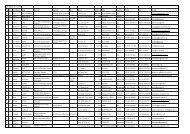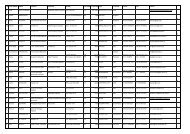icvg 2009 part I pp 1-131.pdf - Cornell University
icvg 2009 part I pp 1-131.pdf - Cornell University
icvg 2009 part I pp 1-131.pdf - Cornell University
You also want an ePaper? Increase the reach of your titles
YUMPU automatically turns print PDFs into web optimized ePapers that Google loves.
— 15 —<br />
GRAPEVINE VIROLOGY HIGHLIGHTS 2006-09<br />
Giovanni P. MARTELLI<br />
Di<strong>part</strong>imento di Protezione delle Piante e Microbiologia A<strong>pp</strong>licata, Università degli Studi and Istituto di Virologia Vegetale del CNR,<br />
Unità Organizzativa di Bari, 70126 BARI, Italy<br />
G.P. Martelli, Tel: +39.080.5442914; Fax:+39.080.544291; E-mail: martelli@agr.uniba.it<br />
Summary<br />
Consistently with the comparable presentations given in the<br />
previous ICVG Meetings, this report summarizes the relevant<br />
information contained in the 200 or so papers on grapevine<br />
virology published since the Stellenbosch Meeting in 2006.<br />
SPECIALIZED MEETINGS AND REVIEWS<br />
Two such Meetings entitled “The Syrah vine health<br />
Symposium” and “Grapevine leafroll disease: an increaing<br />
problem for California vineyards” organized by the<br />
<strong>University</strong> of California, were held at Davis (USA) in 2007<br />
and 2008, respectively. These Meetings, open to<br />
international <strong>part</strong>icipation, reviewed the state-of-the-art of<br />
the diseases dealt with. No ultimate conclusions were<br />
reached on the origin of Syrah decline, although the fact<br />
that this disease is graft-transmissible, perennates in<br />
propagating material, develops in quite different<br />
geographical areas under a wide range of environmental<br />
conditions and has a robust association with at least one<br />
virus of the rugose wood complex (Grapevine rupestris<br />
stem pitting-associated virus, GRSPaV) should favour a<br />
viral aetiology.<br />
As reviewed by Fuchs et al. (2007), studies financed<br />
by the European Commission for assessing the risk of<br />
recombination in grapevines transformed with the coat<br />
protein (CP) gene of Grapevine fanleaf virus (GFLV)<br />
showed that no such event occurred in transgenic plants.<br />
Furthermore, the original variability of Grapevine virus A<br />
(GVA) and Grapevine virus B (GVB) used for infection of<br />
plants transformed with the CP gene of both viruses was<br />
preserved even in the presence of high transcript<br />
accumulation and systemic plant infection. Thus, transgenic<br />
grapes may not represent a threat to the crop and the<br />
environment. A similar subject was addressed in an article<br />
reviewing the outcome of the investigations carried out by<br />
several Europen laboratories in the framework of the EU-<br />
FP6-Coordination Network ResisVir (Laimer et al., <strong>2009</strong>).<br />
Finally, the intriguing properties of GVA were reviewed by<br />
Mawassi (2007) who concluded that in spite of the a<strong>pp</strong>arent<br />
simplicity and small size of its genome, GVA is not a<br />
simple virus.<br />
SURVEYS AND NEW RECORDS OF KNOWN<br />
DISEASES, VIRUSES AND VECTORS<br />
The evaluation of the sanitary status of national<br />
grapevine industries continues to attract the interest of<br />
technicians of various countries. Thus, field surveys were<br />
conducted in the Czech Republic (Kominek, 2008), Iran<br />
(Bashir & Hajizadeh, 1997), Chile (Fiore et al., 2008;<br />
<strong>2009</strong>), Lebanon (Hanna et al.,2008) and Croatia, some<br />
being specifically directed to the occurrence and<br />
distribution of leafroll viruses in Tunisia (Mahfoudhi et al.,<br />
2008), Turkey (Akbas et al., 2007) and the USA (Fuchs et<br />
al., <strong>2009</strong>). Several molecular variants of GRSPaV were so<br />
consistently found in Japanese vines of Vitis labrusca cvs<br />
Pione and Kyoho affected by rugose wood, to suggest their<br />
involvement in the aetiology of this disease (Nakaune et al.,<br />
2008a). Grapevine vein necrosis and grapevine vein mosaic<br />
were recorded for the first time from Syria (Mlsmanieh et<br />
al., 2006a, 2006b), Grapevine virus A (GVA) from<br />
Germany (Ipach & Kling, 2008), Grapevine leafrollassociated<br />
virus 9 (GLRaV-9) from Washington State<br />
(Jarugula et al.,2008) and Australia (Habili et al., 2008),<br />
GLRaV-7 from California (Morales & Monis, 2007),<br />
GLRaV-5 from Argentina (Gomez-Talquenca et al., <strong>2009</strong>),<br />
GLRaV-7 and GLRaV-9 from Chile (Engel et al., 2008a),<br />
GLRaV-4 from Chile (Escobar et al., 2008), GFLV from<br />
Washington State (Merkuria et al., 2008), GLRaV-3 from<br />
American Vitis species in Washingon State (Soule et al.,<br />
2006). An investigation for the presence of Xiphinema<br />
index in the vineyards of the Bekaa valley (Lebanon),<br />
revealed that 14% of the sampled plantings contained the<br />
nematode (Jawar et al., 2006). An intriguing finding came<br />
from Slovenia, where Raspberry bushy dwarf virus<br />
(RBDV), a member of the genus Idaeovirus, was detected<br />
by nested RT-PCR in individuals of the longidorid<br />
nematode Longidorus juvenilis extracted from 4 of 5 soil<br />
samples (Mavric Plesco et al., <strong>2009</strong>). Idaeoviruses are not<br />
known to be nematode-borne, thus if L. juvenilis is able to<br />
transmit RBDV remains to be established. So far, this virus<br />
has only been found in Slovenia, primarily in white-berried<br />
cultivars. It is irregularly distributed in infected vines and is<br />
not transmitted through seeds in cv. Laski Rizling, contrary<br />
to raspberry, where up to 77% seed transmission has been<br />
recorded (Mavric-Plesco et al., <strong>2009</strong>).<br />
NEW DEVELOPMENTS IN TAXONOMY AND<br />
RECORD OF NEW VIRUSES<br />
The continuous flow of molecular information is<br />
affecting taxonomy to an increasing extent. The major<br />
changes occurred recently, that involve also virus species<br />
pathogenic to grapevines, consist in the re-arrangement of<br />
the plant infecting members of the new order<br />
Picornavirales. In <strong>part</strong>icular: (i) the former family<br />
Comovidae was cancelled and substituted for by the new<br />
family Secoviridae, which now includes the genera<br />
Comovirus, Fabavirus, Nepovirus, Sequivirus, Waikavirus,<br />
Cheravirus, Sadwavirus and Torradovirus. Since the extant<br />
genera Comovirus, Fabavirus and Nepovirus still represent<br />
a homogenous grouping, they were assigned to the<br />
Progrès Agricole et Viticole, <strong>2009</strong>, Hors Série – Extended abstracts 16 th Meeting of ICVG, Dijon, France, 31 Aug – 4 Sept <strong>2009</strong>




